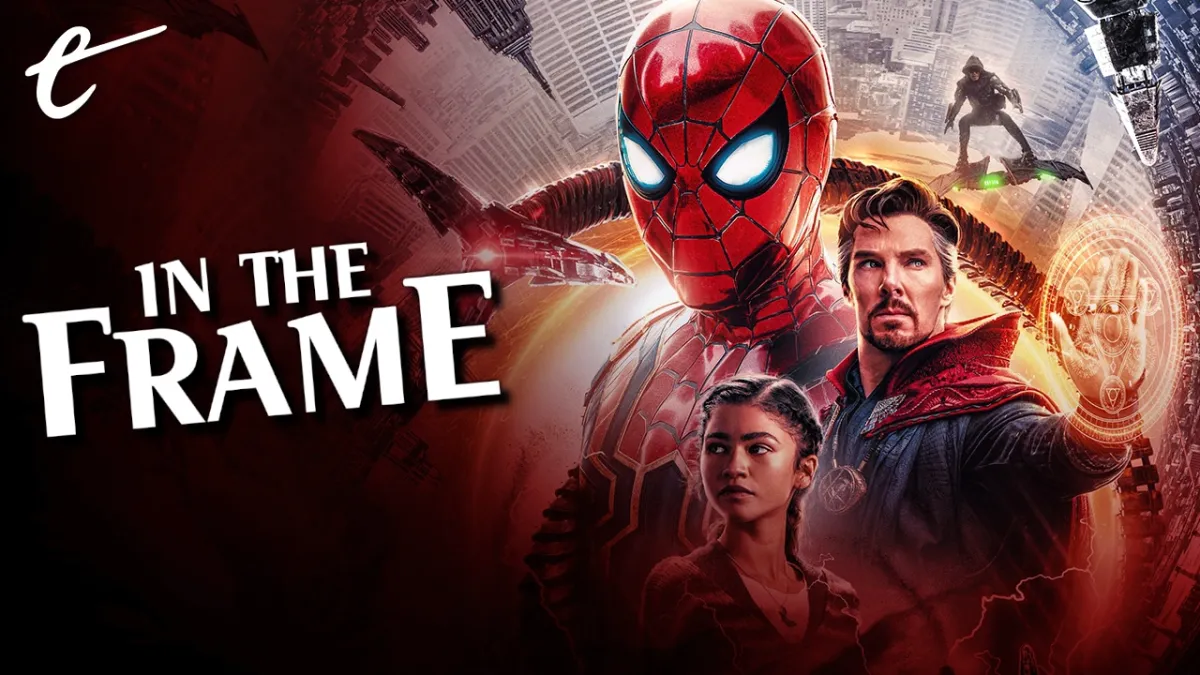This article contains spoilers for Spider-Man: No Way Home. If you haven’t seen it yet but plan to, bookmark this article and come back soon!
Much of the discussion of Spider-Man: No Way Home has focused on the film’s appeal to nostalgia, its inclusion of characters from the two previous live-action Spider-Man franchises. To its credit, No Way Home isn’t just an empty nostalgia delivery vector like Space Jam: A New Legacy or Ghostbusters: Afterlife. It is a movie that is clearly trying to be about something, even if the movie itself never seems entirely sure what that thing is or what it has to say about it.
No Way Home finds Peter Parker (Tom Holland) menaced by a variety of villains from across the multiverse, including Norman Osborn (Willem Dafoe), Otto Octavius (Alfred Molina), and Max Dillon (Jamie Foxx). These villains were snatched from their own universes, moments before their deaths, when Peter accidentally interrupted a magic spell cast by Stephen Strange (Benedict Cumberbatch). Much of the movie revolves around the ethics of sending these characters back home.
This is obviously a genre fiction conceit, with these characters snatched from other live-action iterations of the Spider-Man franchise. However, No Way Home tries to layer in some nuance and complexity to the premise. It turns this continuity tangle into an extended allegory. It’s a surprisingly pointed piece of political commentary, with No Way Home framing this moral dilemma as equivalent to the debate about what to do with dispossessed refugees and immigrants fearing persecution.
Stephen insists that the villains have to be sent home, even knowing that they will die as soon as they return to their home territories. However, Peter comes to view these “visitors” sympathetically, particularly when a traumatized Osborn shows up in the F.E.A.S.T. soup kitchen operated by his Aunt May (Marisa Tomei), starving and in rags. Osborn was once a scientist and a leader, until circumstances robbed him of everything that he held dear.

In the past few years, immigration has become a particularly charged topic in the United States. In recent years, immigrants have been detained at the borders of the United States without due process and separated from their families. The Marvel Cinematic Universe has touched on this theme on a couple of occasions, most notably with the Skrull refugees in Captain Marvel and the Flag Smashers in The Falcon and the Winter Soldier.
Spider-Man: No Way Home aggressively leans into this metaphor. Much of the movie’s second act finds Peter tracking down these refugees and locking them away in cages beneath Strange’s Sanctum Sanctorum. There is no court of appeal. There is no public scrutiny. Stephen just gives a teenager a magic gauntlet that has the power to straight up “disappear” people. Peter apprehends many of these “canon immigrants” when they are just talking peacefully, like Flint Marko (Thomas Hayden Church).
“If we send them back, they’ll die,” Peter states at one point, summarizing the moral obligation to help those dispossessed individuals fleeing tyranny and oppression. The movie’s climactic battle takes place at the Statue of Liberty, with Peter explicitly drawing attention to how the monument is a beacon to “second chances.” It is a living reminder of America’s (often unfulfilled) promise to those “masses yearning to breathe free.” It’s a refreshingly bold take for a movie like this.
However, it’s also incredibly muddled and messy. No Way Home accepts that holding immigrants without due process and sending them back to certain death is a bad thing, but the movie never seems entirely sure what the alternative is. No heroic member of the cast, even Peter, seriously suggests letting them stay in their new home where there’s no threat of imminent death. These refugees are decidedly less welcome than the Skrulls were at the end of Captain Marvel.

Spider-Man: No Way Home certainly mixes its metaphors. The climax of No Way Home finds Stephen floating atop the Statue of Liberty, repelling armies of immigrants from alternate dimensions. “They’re starting to come through, and I can’t stop them!” Stephen shouts. It feels like the movie is trying to have its cake and eat it, particularly when the climax portrays several of these migrants as monsters — whether figuratively like Osborn or literally like the Lizard (Rhys Ifans).
The movie’s morality becomes even more contradictory when it comes to trying to square this circle. Peter ultimately figures that if he can “fix” these villains and send them home without their powers, that will mean that they won’t die when they return to their home dimension. The logic of this is fuzzy at best. Given that the characters are returning mere seconds before their deaths, it seems strange to assume that just dropping them back into deadly situations will work itself out.
No Way Home makes the standard superhero argument that killing people is bad. This is pretty understandable. Killing people generally is bad. However, superhero fandoms can fixate and obsess on this idea as an arbitrary line within genre fiction, leading to surreal debates about whether Batman shooting a vampire or killing an alien “counts” as killing, and implying that it’s fine for characters to fire machine guns indiscriminately as long as they are firing rubber bullets.
It should be noted that this version of Spider-Man wears a superhero costume with an “instant kill mode,” which he employed against an army of aliens in Avengers: Endgame. He was also gifted control of a fleet of killer drones in Spider-Man: Far From Home. So while the “killing is bad” argument is a simple and sturdy moral crux for No Way Home, it might behoove this version of Peter Parker to engage in some introspection before he starts casting stones.

After all, the death of these villains followed the standard rules of family-friendly blockbuster cinema. They weren’t directly killed by the heroes, but were often victims of their own arrogance and hubris. Osborn was impaled on his own glider while trying to literally stab his version of Peter Parker (Tobey Maguire) in the back. After almost destroying New York, Octavius sacrificed himself in a moment of redemption to save the city. Their deaths aren’t anybody’s fault but their own.
Still, Spider-Man: No Way Home draws a fairly reasonable line in the sand that killing is bad and makes the moral argument that Peter has an obligation to use his power to help those that he can. Like the movie’s argument that deportation to certain death is unconscionable, it’s a solid premise for the movie that provides clear stakes. Unfortunately, No Way Home very quickly muddles all of this as it wades into the weird rules and conventions of genre fiction.
Peter determines that he can “cure” Osborn of the mental imbalance that transformed him into the Green Goblin. This is perhaps a thorny suggestion, given that Osborn’s decision to experiment on himself in Spider-Man hints that the formula enhanced an already existing part of his personality rather than simply “turning” him evil. No Way Home provides Peter with some magic green glowing juice that can make Osborn good again.
No Way Home never really explains what this formula is and how it works on Osborn’s brain. The movie’s third act hinges on Osborn’s psychosis asserting itself and declining to serve as a weird guinea pig for this formula that was cooked up in the spare room of Happy Hogan’s (Jon Favreau) condominium. Given that the “Goblin” part of Osborn’s psyche manifests itself through voice and body language changes, silencing it would arguably be euthanizing a personality.

For Spider-Man: No Way Home, the “no killing” rule appears to be a simple matter of bodily integrity rather than anything more considered or nuanced. After all, the entire plot of No Way Home is spurred by Peter asking Stephen to erase the memories of the entire world without their consent. That is surely a grotesque violation of their own autonomy and sense of self, but it skirts by unexamined. The film’s climax finds Stephen finally following through and employing the spell.
What’s interesting about this decision is that this is still framed as Peter’s choice to make. It’s presented as Peter’s sacrifice. However, Peter is the only person whose autonomy isn’t violated by this enchantment. No Way Home acknowledges that the spell will wipe the memories of his girlfriend MJ (Zendaya) and his best friend Ned (Jacob Batalon), but Peter doesn’t ask for their consent. He makes the decision and tells them. (MJ had earlier asked him to consult her.)
As such, the ethics of No Way Home feel more than a little arbitrary. The film posits that killing is bad. However, erasing entire personalities and rewriting memories without informed consent is apparently fine. To be fair, this weird double standard is not unique to No Way Home. The theatrical cut of Superman II and the fourth season finale of the revived Doctor Who feature similarly icky violations of characters’ autonomy and identity without consent.
To give credit to No Way Home, these thematic contradictions arise within the narrative because the film is trying to say something interesting and engaging in the midst of all its fan service and homage. There is ambition and earnestness within the film, blended with good intentions. However, No Way Home often loses sight of these threads and fails to tie them together into internally consistent or coherent statements that articulate what the film is trying to say.
Spider-Man: No Way Home definitely has things to say beyond its nostalgia for past iterations of the Spider-Man franchise. It just can’t seem to figure out exactly what those things actually are.






Published: Dec 17, 2021 11:00 am